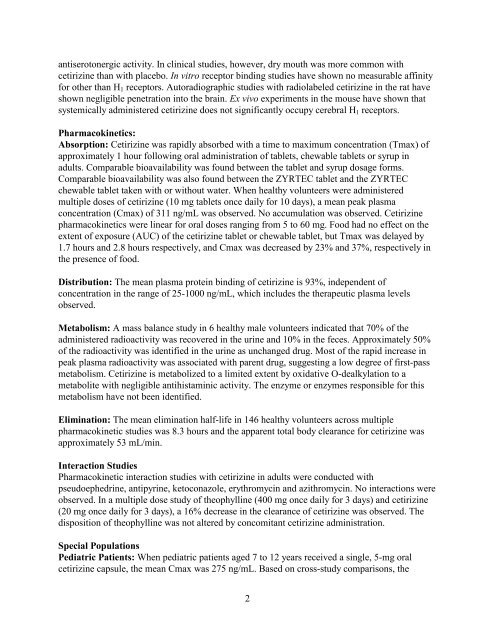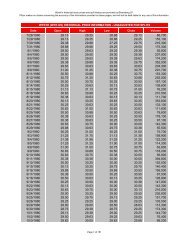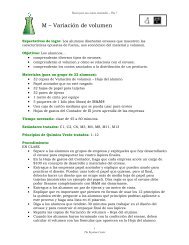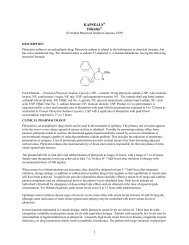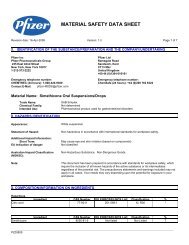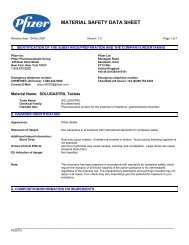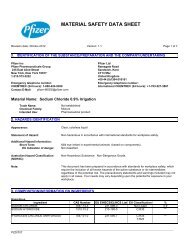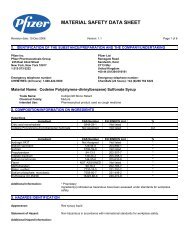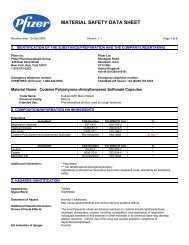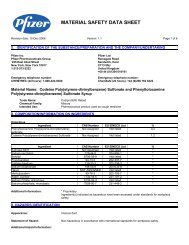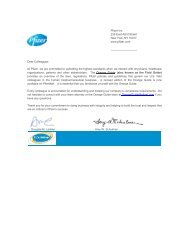ZYRTEC® (cetirizine Hydrochloride) Tablets, Chewable ... - Pfizer
ZYRTEC® (cetirizine Hydrochloride) Tablets, Chewable ... - Pfizer
ZYRTEC® (cetirizine Hydrochloride) Tablets, Chewable ... - Pfizer
Create successful ePaper yourself
Turn your PDF publications into a flip-book with our unique Google optimized e-Paper software.
antiserotonergic activity. In clinical studies, however, dry mouth was more common with<br />
<strong>cetirizine</strong> than with placebo. In vitro receptor binding studies have shown no measurable affinity<br />
for other than H1 receptors. Autoradiographic studies with radiolabeled <strong>cetirizine</strong> in the rat have<br />
shown negligible penetration into the brain. Ex vivo experiments in the mouse have shown that<br />
systemically administered <strong>cetirizine</strong> does not significantly occupy cerebral H1 receptors.<br />
Pharmacokinetics:<br />
Absorption: Cetirizine was rapidly absorbed with a time to maximum concentration (Tmax) of<br />
approximately 1 hour following oral administration of tablets, chewable tablets or syrup in<br />
adults. Comparable bioavailability was found between the tablet and syrup dosage forms.<br />
Comparable bioavailability was also found between the ZYRTEC tablet and the ZYRTEC<br />
chewable tablet taken with or without water. When healthy volunteers were administered<br />
multiple doses of <strong>cetirizine</strong> (10 mg tablets once daily for 10 days), a mean peak plasma<br />
concentration (Cmax) of 311 ng/mL was observed. No accumulation was observed. Cetirizine<br />
pharmacokinetics were linear for oral doses ranging from 5 to 60 mg. Food had no effect on the<br />
extent of exposure (AUC) of the <strong>cetirizine</strong> tablet or chewable tablet, but Tmax was delayed by<br />
1.7 hours and 2.8 hours respectively, and Cmax was decreased by 23% and 37%, respectively in<br />
the presence of food.<br />
Distribution: The mean plasma protein binding of <strong>cetirizine</strong> is 93%, independent of<br />
concentration in the range of 25-1000 ng/mL, which includes the therapeutic plasma levels<br />
observed.<br />
Metabolism: A mass balance study in 6 healthy male volunteers indicated that 70% of the<br />
administered radioactivity was recovered in the urine and 10% in the feces. Approximately 50%<br />
of the radioactivity was identified in the urine as unchanged drug. Most of the rapid increase in<br />
peak plasma radioactivity was associated with parent drug, suggesting a low degree of first-pass<br />
metabolism. Cetirizine is metabolized to a limited extent by oxidative O-dealkylation to a<br />
metabolite with negligible antihistaminic activity. The enzyme or enzymes responsible for this<br />
metabolism have not been identified.<br />
Elimination: The mean elimination half-life in 146 healthy volunteers across multiple<br />
pharmacokinetic studies was 8.3 hours and the apparent total body clearance for <strong>cetirizine</strong> was<br />
approximately 53 mL/min.<br />
Interaction Studies<br />
Pharmacokinetic interaction studies with <strong>cetirizine</strong> in adults were conducted with<br />
pseudoephedrine, antipyrine, ketoconazole, erythromycin and azithromycin. No interactions were<br />
observed. In a multiple dose study of theophylline (400 mg once daily for 3 days) and <strong>cetirizine</strong><br />
(20 mg once daily for 3 days), a 16% decrease in the clearance of <strong>cetirizine</strong> was observed. The<br />
disposition of theophylline was not altered by concomitant <strong>cetirizine</strong> administration.<br />
Special Populations<br />
Pediatric Patients: When pediatric patients aged 7 to 12 years received a single, 5-mg oral<br />
<strong>cetirizine</strong> capsule, the mean Cmax was 275 ng/mL. Based on cross-study comparisons, the<br />
2


